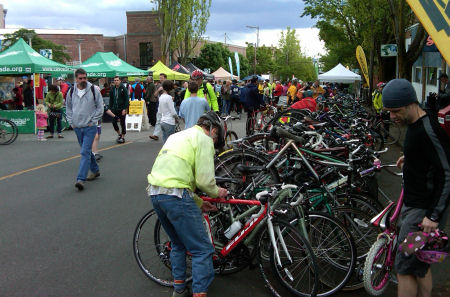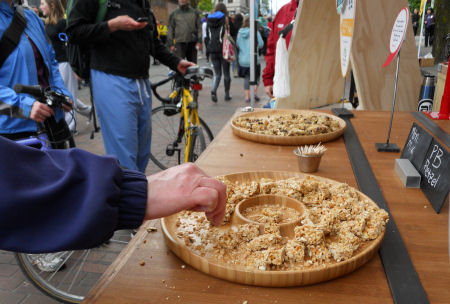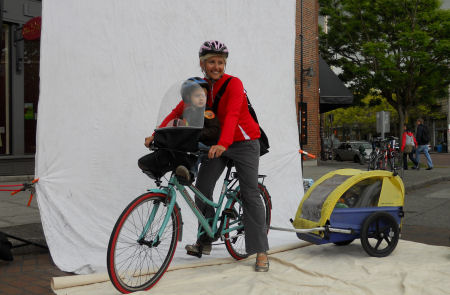Cyclists from across north Seattle pedaled their way to downtown Ballard for the Bike to Work After Party and Summer Streets event on 22nd Avenue between Ballard Avenue NW and NW Market Street earlier this evening.
Hundreds of brightly dressed, helmet-wearing, Lycra clad riders took to the street, snagging free offerings from various vendor booths, including these Cliff Bar samples.
Many waited in line to ride the Dutch Bicycle Company’s humongous, seven-seat Conference Bike.
Some had their picture taken by Michael Stearns as part of his ByPedal Project.
In this clip, Michael explains his project and works with a rider to capture her image.
Madi, here in this picture, took off a few minutes later on the Kidical Mass bike ride, which according to their site is an “easy-going, and law-abiding family bike ride for kids of all ages.”
Alas, minutes after they left at 6 p.m., a drenching rain arrived, encouraging many of the riders to make a damp dash for home.
Here’s a clip of Kidical Mass heading out on their ride.





Were there booths about mandatory license plates and safety classes etc? And why not? They do want to fit in, like boaters, right? They do want to be able to be ID’d when running red lights etc, right? They do want to pay for showers at their place of business, right? Seems to me that during these days of revenue enhancement they’d like to help do their part, right? Or are we all supposed to foot that bill too? Pay for play. Time for the CBC to pony up and get serious. Not another unfunded mandate by them and our community organizing mayor. Imagine the $$ raised by them and them alone to do what they want to with it. Isn’t most everything else “fee based” around here? Aren’t we already taxed to the max? Didn’t we just say NO, again, yesterday? Pay-for-play CBC.
Yo Norwegian, Try providing some facts to back up your nonsense. The fact is cars are heavily subsidized.
“From Suburban Nation: The Rise of Sprawl and the Decline of the
American Dream by Andres Duany, Elizabeth Plater-Zyberk, and Jeff
Speck
THE AUTOMOBILE SUBSIDY
“According to Hart and Spivak, government subsidies for highways and
parking alone amount to between 8 and 10 percent of our gross
national product, the equivalent of a fuel tax of approximately $3.50
per gallon. If this tax were to account for the “soft” costs such as
pollution cleanup and emergency medical treatment, it would be as
high as $9.50 per gallon. The cost of these subsidies –
approximately $5,000 per car per year – is passed directly on to the
American citizen in the form of increased prices for products or,
more often, as income, property, and sales taxes. This means that
the hidden costs of driving are paid by everyone: not just drivers,
but also those too old or too poor to drive a car. And these people
suffer doubly, as the very transit systems they count on for mobility
have gone out of business, unable to compete with the heavily
subsidized highways.”
And here is another study about the cost to society of automobiles…..
“This report by the International Center for Technology Assessment (CTA) identifies and quantifies the many external costs of using motor vehicles and the internal combustion engine that are not directly reflected in the retail price Americans pay for gasoline. These are costs that consumers pay indirectly by way of increased taxes, insurance costs, and retail prices in other sectors.
The report divides the external costs of gasoline usage into five primary areas: (1) Tax Subsidization of the Oil Industry; (2) Government Program Subsidies; (3) Protection Costs Involved in Oil Shipment and Motor Vehicle Services; (4) Environmental, Health, and Social Costs of Gasoline Usage; and (5) Other Important Externalities of Motor Vehicle Use. Together, these external costs total $558.7 billion to $1.69 trillion per year, which, when added to the retail price of gasoline, result in a per gallon price of $5.60 to $15.14. “
Yeah, but nobody ever got laid on the back on a bike….
So Vern, get rid of all cars tomorrow and how long do you think the US economy would last? c
Cars are one of the single revolutionary products that are responsible for this nation’s wealth and, if you remember your teen years well, freedom. James Dean didn’t ride a tricycle.
Having said that, I hope in my lifetime they can make electric cars that are as practical, useful and powerful as gas driven cars .
James Dean is dead.
At least he died like a man and wasn’t wearing spandex.
where was your booth Norwegian? Or is this your ebooth? whine whine whine.
Love it, ‘single file’, then everyone rides down the street 3 a breast.
[Apologies if this double-posts. Don’t love the new comment system.]
Kidical Mass guy here – It got single file right quick – what you saw was parents trying to slot in behind their kids at the very beginning of the ride.
And for the record, I’m not aware of “many” (if any) riders making a dash for home. We did huddle under the Ballard bridge, gearing up. And then we bailed at Hale’s, for a lovely dinner. The ride home was dry, at least.
There are ways to have fun that don’t involve “getting laid in the back of your car”, you know. But you keep on reliving that dream.
Cars do a lot of things well, and were revolutionary in their way (as were bicycles). But these days cars and SUVs make a lot of 1-2 mile trips that could easily be replaced by biking or walking. Without a lick of spandex involved, if your masculinity is so threatened.
Did any rogue car drivers run through this street spitting on cyclists or kicking their bikes?